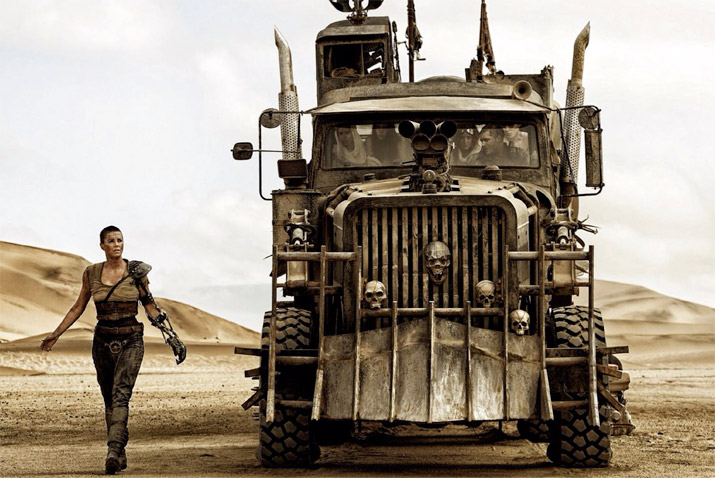By providing your information, you agree to our Terms of Use and our Privacy Policy. We use vendors that may also process your information to help provide our services. This site is protected by reCAPTCHA Enterprise and the Google Privacy Policy and Terms of Service apply.
‘Fury Road’ Isn’t the Only New ‘Mad Max’ Story Released This Year

READ MORE: ‘Mad Max: Fury Road’ is the Best Action Movie of the Year
In “Mad Max Beyond Thunderdome,” Tina Turner played Aunty Entity, the ruthless mistress of Bartertown. She also performed the songs accompanying the opening and end credits, two synth-heavy guitar ballads that were emblematic of their decade. On the movie’s opening weekend, Ronald Reagan was president, Queen was raising money to fight famine at the Live Aid concert, and Coca Cola was trying to backpedal away from New Coke as fast as possible.
In other words, “Beyond Thunderdome” was a creature of the eighties, which makes it all the more impressive that “Mad Max: Fury Road” managed to bring the franchise back to life this year without looking dated.
Sublimating the “Mad Max” series for a modern audience was no easy feat. But Miller kept alive the freakish, carnivalesque qualities of the original while making a savagely propulsive movie that looks and sounds like it belongs in 2015.
And it’s been a bountiful year for the wasteland. Only three months after “Fury Road,” Avalanche Studios released its own “Mad Max,” an open-world action-adventure game starring the eponymous wanderer. It’s the first “Mad Max” videogame in 25 years, and bizarrely, it’s pretty similar to the last one.
At the very least, the new game has a similar rhythm to the old one: Both find the player traversing the wasteland in an apocalyptic hot-rod, dodging and fighting with other mounted raiders. In between stretches of driving, Max will disembark for a little hand-to-hand-to-shotgun action, raiding bunkers and camps to acquire supplies. Despite being separated by a sizable gulf of years, both games recognize that Max is not a sort of chromed centaur — it’s vital to the mythos that he occasionally separates from the vehicle.
The new game, of course, looks a lot better. In fact, it’s shockingly beautiful. Visually, “Mad Max” borrows heavily from the “Fury Road” stylebook. White-painted War Boys holler about Valhalla, pursuing their prey in paint-stripped coupes. When an enemy camp is alerted to your presence, they fire off signal flares. The music quiets so you can hear the projectiles whistle as they rise into the sky and explode in red and yellow bursts of color. It’s deeply reminiscent of Immortan Joe’s flares calling his war parties together.
In interviews, Miller has discussed the challenge of making his movies visually interesting, when the desert landscape only offered him “the usual teal-and-orange thing.” Facing that same problem, Avalanche put an enormous amount of effort into differentiating the environment, a vital task for a game in which exploration and discovery play such a major role. The result is a more visually diverse apocalypse than anything else in a game of this scale, with craggy peaks, subterranean tunnels, salt flats, tar pits and the perpetually burning flames of Gastown in the distance.
 Mechanically, the game is unmistakably contemporary, which sometimes works to its detriment. The combat, for example, is nearly a carbon copy of the popular Batman “Arkham” games: Enemies can be countered with the push of a button, and biffed with another. The result, when played skillfully, renders fights balletic and seemingly choreographed; while that’s great for Batman, it hardly fits the desperate world that Max inhabits.
Mechanically, the game is unmistakably contemporary, which sometimes works to its detriment. The combat, for example, is nearly a carbon copy of the popular Batman “Arkham” games: Enemies can be countered with the push of a button, and biffed with another. The result, when played skillfully, renders fights balletic and seemingly choreographed; while that’s great for Batman, it hardly fits the desperate world that Max inhabits.
The game also employs the “Assassin’s Creed” model for motivating players, usually dubbed “icon hunt.” The wasteland is just full of stuff to collect —scrap, water, project plans, and collectibles, most of which is marked with a bright icon to keep even the most distractible player on track. But while there’s plenty of objects, the game doesn’t provide many options for interacting with them. If you’re not smashing cars, you’re punching dudes of one variety or another. After a while, it starts to feel like routine, and never dangerous.
The game takes place shortly after the events of “Fury Road,” but “Mad Max” is better understood as a standalone entry in the canon. The scant references to Immortan Joe and the Citadel feel obligatory, and Max himself looks nothing like the brick house version of Tom Hardy. However, the connective tissue between the films has never been plot anyway; the series is continuous due to a shared aesthetic of spikes, leather and rust.
Still, this player found himself wishing that the game had taken more cues from “Fury Road.” Maybe, safely seated in the roaring engine George Miller sketched out storyboard by storyboard, the developers would have felt more comfortable taking risks. At the very least, the game might have featured more diversity in its cast, and probably a more nuanced treatment of its female characters.
Nevertheless, there’s a lot of care for the source material: You can hear it in the way the car revs to life each time Max climbs back into his car. But in their effort to bring this series to a modern audience, the developers of “Mad Max” made a game that looks all too much like the rest of the 21st century.
By providing your information, you agree to our Terms of Use and our Privacy Policy. We use vendors that may also process your information to help provide our services. This site is protected by reCAPTCHA Enterprise and the Google Privacy Policy and Terms of Service apply.















